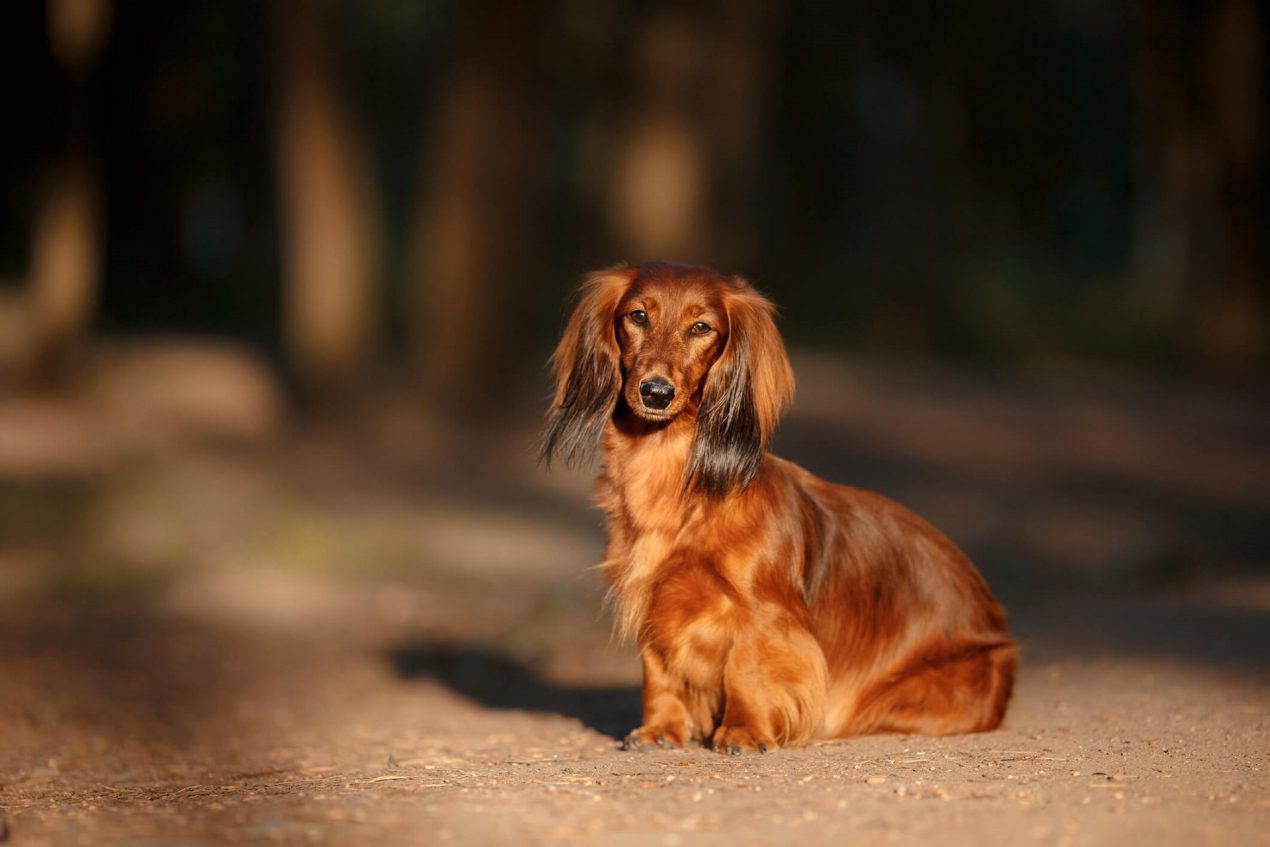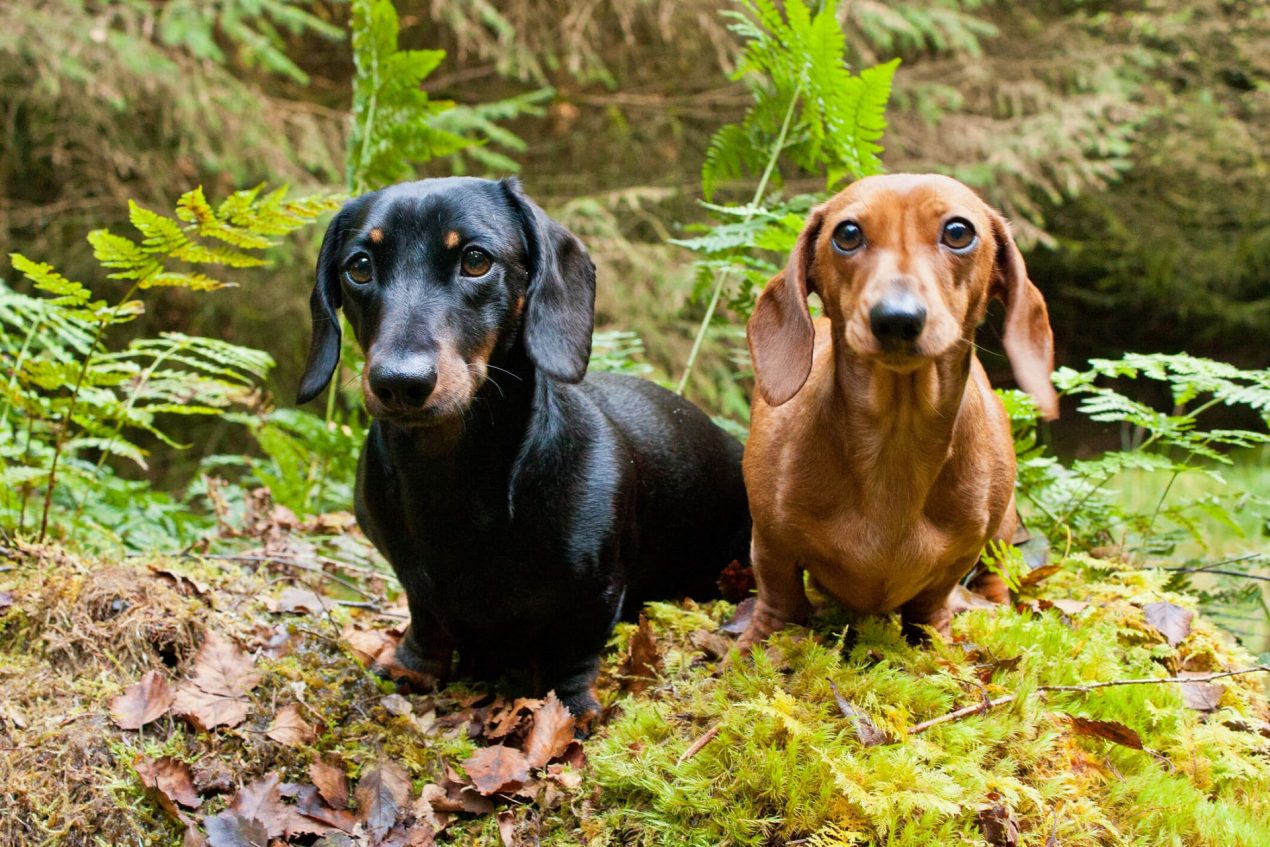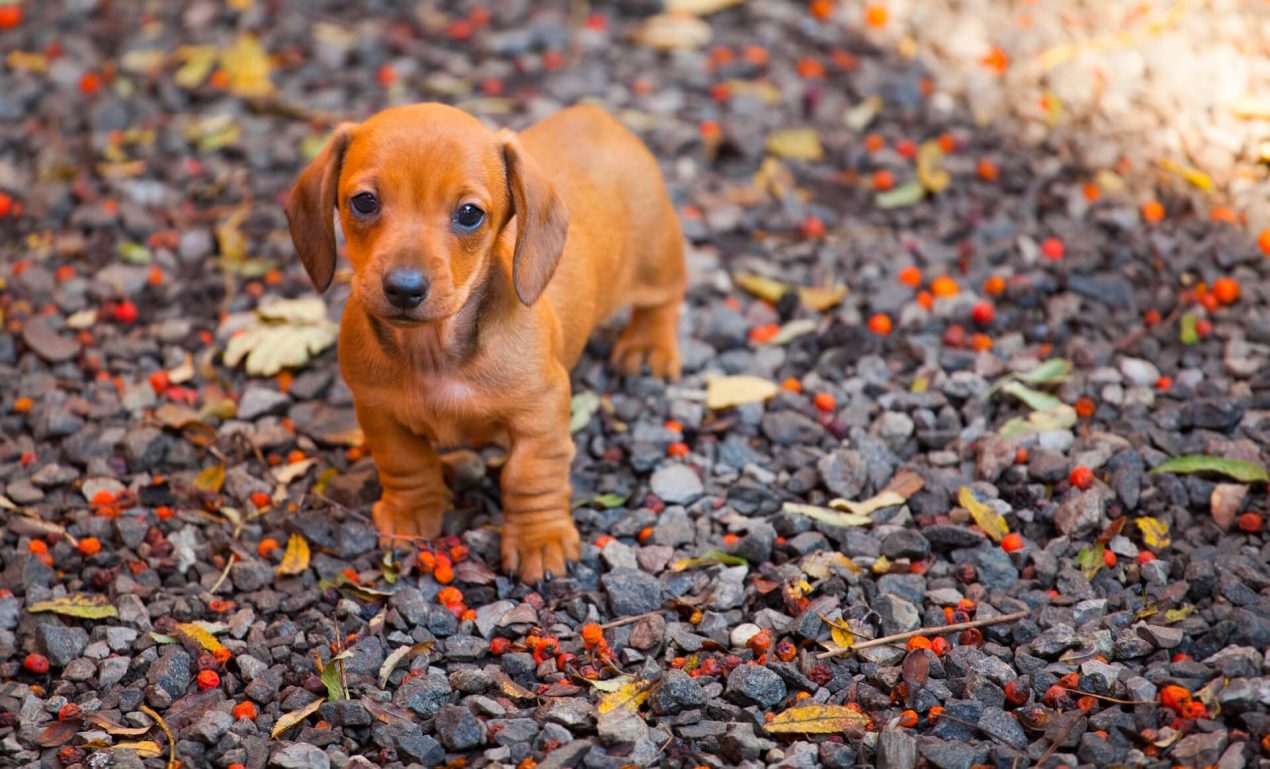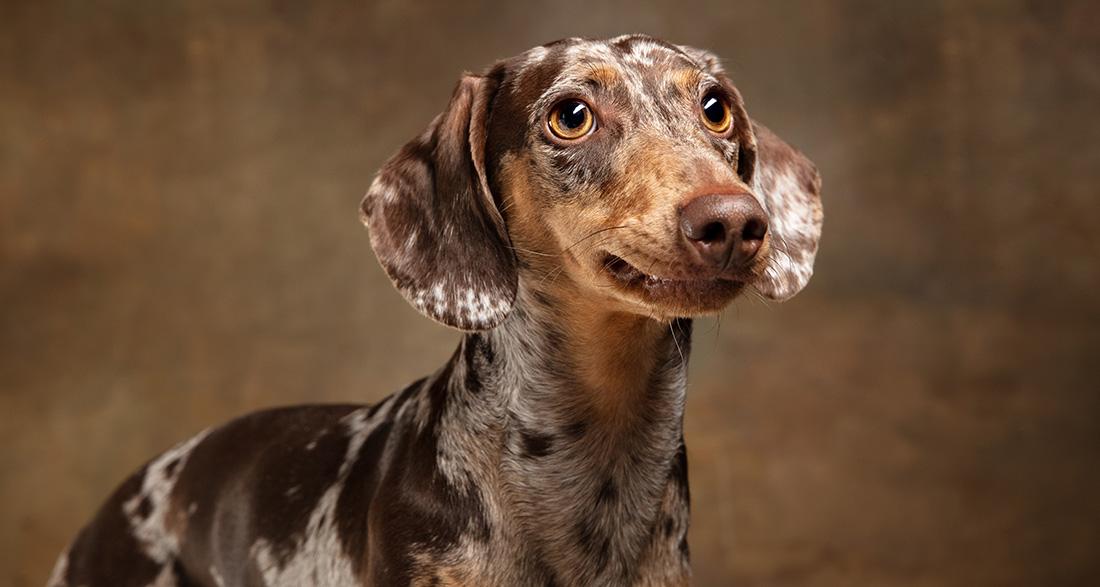The unmistakable Dachshund gaze, cheeky demeanor, and distinctive body structure make the Dachshund (also known as Doxie or Teckel) one of the most well-known dog breeds. Learn about the characteristics that set apart this ancient hunting breed in this profile.
History of the Dachshund
The ancient ancestors of today’s Dachshund are said to have assisted Celtic tribes in hunting. The so-called Bracken, known for their hunting skills, were particularly short-legged. These dogs excelled, especially in tracking human scents. The Keltenbracke is considered the forefather of Dachshunds for this reason. During the Middle Ages, they were also popular for hunting badgers, foxes, or protecting against chickens and crop damage. Farmers needed a dog that could follow prey into burrows, and so, the short-, crooked-legged Keltenbracken became fashionable and were bred more extensively.
In 1560, a book on dogs mentioned special hounds suitable for hunting in badger and fox dens. In 1879, some breeders established the first breed standards. Nine years later, Klaus Graf Hahn and Dr. Emil Illgner founded the “Deutscher Teckelclub” (German Dachshund Club), which continues to exist today. Currently, three different Dachshund breeds are officially recognized: Smooth-haired, Long-haired, and Wirehaired Dachshunds, each in three different sizes.
The breed is officially recognized by the FCI and the AKC under the name Dachshund. It has its own FCI group, which is divided into a single section dedicated to Dachshunds. The breed is also commonly referred to as Daxio or Teckel.
Breed Overview
GROUP: Hound
HEIGHT: 8 to 9 inches (standard); 5 to 6 inches (miniature)
WEIGHT: 16 to 32 pounds (standard); up to 11 pounds (miniature)
TEMPERAMENT: Clever, playful, stubborn, devoted, lively, independent, courageous
COAT: Varieties include smooth (shorthaired), longhaired, and wire-haired
COAT COLOR: Colors include (but not limited to) black, tan, fawn, beige, blue, chocolate, and red with various markings such as dapple, piebald, brindle, and sable
HYPOALLERGENIC: Yes
LIFE SPAN: 12 to 16 years
Temperament and Character
Because Dachshunds were originally bred for hunting larger animals, they remain courageous, confident, and feisty to this day. Pay attention to their interactions with small animals to prevent them from chasing or capturing them. Additionally, Dachshunds often show little respect for other, even larger, dogs. They have no qualms about confronting them and defending their position with barking.
Due to their mistrustful and vigilant nature, they excel as watch dogs and are often mistaken for being overly barky or aggressive. However, with consistent training, their somewhat stubborn and independent nature can be effectively managed, turning them into affectionate companions who are loyal and friendly to their owners. Nevertheless, they are not recommended for novice dog owners. They enjoy being petted and playing with children but may not be as fond of interacting with other dogs.
Suitability as Family Dogs:
They are loving and loyal companions, making them suitable family dogs. Their playful and sometimes clownish nature adds joy to everyday life.
Typical Behaviors and Personality Traits Dachshunds are known for their alertness, courage, and inclination toward independent thinking. They can be territorial and tend to form a strong bond with their owners.
| Affection Level | High |
| Friendliness | Medium |
| Kid-Friendly | Low |
| Pet-Friendly | Low |
| Exercise Needs | Medium |
| Playfulness | High |
| Energy Level | Medium |
| Trainability | Medium |
| Intelligence | Medium |
| Tendency to Bark | High |
| Amount of Shedding | Medium |
Appearance of the Dachshund
In Dachshund breeding, there are three different size categories: Standard Dachshund, with a chest circumference over 35 cm and a maximum weight of nine kilograms; Miniature Dachshund, with a chest circumference of 30 to 35 centimeters; and Rabbit Dachshund, with a chest circumference of a maximum of 30 centimeters.
Breeders classify the dogs into three coat variations:
- Long-haired
- Wirehaired
- Smooth-haired
Many colors are recognized, but entirely black coloring is not allowed, and white spots are also undesirable. In the USA, some color variations not officially recognized in some countries in Europe exist, such as the Piebalds, known for their spotted coats. The Tiger Dachshund with a special merle coloring is also widespread, resulting from a gene mutation found in other breeds like the Australian Shepherd or Shetland Sheepdog.

Puppy Training
The little Dachshund is a cheeky and confident dog that should be shown the ropes early on. Consistent training is crucial because you don’t want the little hunting dog to run circles around you. Also, before off-leash walks, ensure that you can control the dog’s pronounced hunting instinct. This guarantees that the dog won’t dash into the underbrush.
Force and coercion won’t get you far with Dachshunds, as their independent nature will resist. Positive reinforcement and rewards work better, showing the dog that obeying is worthwhile. It’s best to gently but firmly establish boundaries with the puppy from the beginning.
Training Tips:
Dachshunds benefit from early and consistent training. Their hunting instinct can be directed through suitable exercises and games in controlled situations.
Importance of Socialization:
Socializing with other animals and children from an early age is essential to encourage well-adjusted behavior. Despite their sometimes stubborn character, they are trainable and respond well to positive training.
Activities with the Dachshund
Despite being a small dog, the Dachshund, with its strong self-esteem and love for movement, requires appropriate engagement. Keeping your Dachshund fit and healthy, along with strengthening your bond, is possible through exciting games and meaningful activities. Due to their long backs, these dogs are not suitable for dog sports like agility.
They feel more at home digging up the garden, earning them the nickname “earth pig.” A garden that the dog can plow at will is essential for their appropriate care. While many Dachshunds enjoy cuddling, they are by no means lap dogs. Daily walks are a must for these agile and enduring dogs.

Health and Care
Generally, these dogs have a longer life expectancy of 12 to 16 years compared to other breeds. Some individuals of the breed may experience issues in old age due to their unique body structure. The so-called Dachshund paralysis, a type of herniated disc, is more common in elderly Dachshunds. Affected animals may have difficulty controlling their hind legs and struggle with movement. Dachshunds do not have specific dietary requirements, consuming both wet and dry food. To maintain overall fitness and minimize the risk of illness, they should remain slim and agile.
Common Health Problems:
Dachshunds are prone to certain health problems, including spinal issues due to their long backs, heart problems, and eye conditions.
Coat Care and Nutrition:
Grooming requirements vary depending on the coat type. A balanced diet is crucial to prevent obesity, which can strain their spine.
Health Prevention and Dealing with Breed-Specific Conditions:
Regular veterinary check-ups and attention to adequate physical activity and nutrition are important to keep this breed healthy.
Is the Dachshund Right for Me?
Anyone interested in getting a Dachshund should be aware that it is by no means a small lap dog. The Dachshund remains active for a long time and requires a lot of stimulation. Therefore, getting a Dachshund puppy should be a well-considered decision. They need an active owner with enough time to physically and mentally engage them.
Ideally, a large house with a garden would be suitable, but they can also be content in an apartment with proper stimulation. If you are sure that the breed fits your lifestyle, you need to find a reputable breeder affiliated with the American Kennel Club. Many breeders ask for between 1,000 and 1,500 dollars for a purebred puppy with papers and vaccinations, depending on color and coat type. A good alternative to a breeder puppy is, of course, adopting a Dachshund from a shelter. For a small fee, you can give a new chance to an innocent animal in need.
Adaptability to Different Living Environments:
Dachshunds can adapt to a variety of living situations, from apartments to houses with gardens. Their size and adaptability make them versatile companions.
Compatibility with Different Lifestyles:
They are suitable for various lifestyles, including active individuals and families. Regular exercise and mental stimulation are essential for their well-being.
Importance of Regular Exercise and Mental Stimulation:
Despite their small size, Dachshunds need daily exercise and mental challenges to stay healthy and balanced.

Interesting Facts
The Dachshund is a popular dog breed worldwide due to its distinctive appearance. In English-speaking countries, it has nicknames like Hotdog, Wiener Dog, or Doxie. In its home country, Germany, the Dachshund has deep roots from the beginning. Even the hunting enthusiast Kaiser Wilhelm II owned some Kaiser Dachshunds. According to stories, his Dachshunds Wadl and Hexl allegedly hunted and ate one of Archduke Franz Ferdinand’s Golden Pheasants during a visit to his estate.
The breed was also popular among celebrities later on. Picasso had a male named Lump, who served as a model for some of his works. Additionally, the Dachshund was the official mascot of German athletes in the 1972 Olympics. At that time, around 28,000 puppies were born annually. The number has decreased over the years and is now around 6,300 puppies born per year.
Do you have a Dachshund or are you considering getting one? Share in the comments what makes them special in your opinion!


